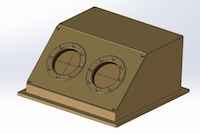FORMOSAT-9A/SWIP 福衛九A號衛星/太空天氣探測儀計畫主持人:趙吉光教授
Space Weather Imager and Probe (SWIP) developed by a joint team of National Central University and National Cheng-Kung University is proposed to install on the 1st satellite of the FORMOSAT-9 (FS-9) conducted by the Taiwan Space Agency (TASA). The main scientific objective is to study the ionosphere space weather effects and to improve the capability of ionosphere data assimilation forecast model. The secondary objective is to implement the GNSS-RO/R payload expected to be on board FS-9. As electron density profile retrieved from GNSS-RO requires knowledge of the topside density at satellite height, in-situ density measured by SWIP can give Abel inversion the correct electron density to start with. SWIP can explore short-term variations of the ionosphere perturbations at dawn/dusk sectors where such kind of perturbation is prominent due to sun rise/set. These perturbations are main drivers to the space communication disruption and navigation outages. As we are now heading to the solar maximum of Solar Cycle 25, the ionosphere perturbations have already become prominent affecting the space technologies according to several research reports. Just like Advanced Ionospheric Probe (AIP) onboard FORMOSAT-5 (FS-5) satellite, CIP is also an all-in-one plasma sensor and is capable of measuring ion concentration, velocity, and temperature. Furthermore, CIP has full-time operation capability but a smaller dimension, mass, and power consumption than AIP. TeNeP also has similar characters and provides in-situ electron temperature and density measurements. SWIP which combines CIP and TeNeP provides full observations of ion and electron of the ionosphere. It not only will benefit the ionosphere data assimilation forecast model but also give glimpse of thermosphere neutral density through the model calculation. By knowing ion and electron temperature simultaneously, ion-neutral collision frequency could be assessed and neutral density variations could be derived. Another application is that recent studies have shown the GNSS-RO is suffered from Radio Frequency Interference (RFI) at specific regions impacting the accuracy of ionospheric irregularity measurements. SWIP on the other hand is not affected by RFI and could provide the accurate measurement of ionosphere irregularity. SWIP can incorporate other similar payloads, like FORMOSAT-5/AIP, FORMOSAT-7 constellation/Ion Velocity Meter, INSPIRESat constellation/CIP, and PEARL-1C/CIP to establish a space weather monitoring system to substitute Defense Meteorological Satellite Program series satellites for a preliminary phase of Taiwanese Space Situational Awareness
依據國家太空中心採購案號:TASA-S-1130204福衛九號第一顆衛星科學酬載研製招標公告,本團隊結合國立中央大學與國立成功大學共同提出太空天氣探測儀(Space Weather Ionosphere Probe, SWIP)研製計畫,可完全符合招標的需求與時程。主要科學目標為太空天氣科學研究與應用於太空天氣預報模型之觀測資料,並提供福衛九號可能搭載之GNSS掩星/反射(GNSS-RO/R)酬載於衛星實地高度之電漿參數,以利於掩星酬載之資料反演。提案之SWIP科學酬載可同時量測電離層離子與電子參數,將可觀測太空天氣事件對電離層離子與電子的影響,也提供電離層太空天氣預報模式完整的電離層電漿觀測,有助於提升預報模式之輸出精準度。善用福衛九號衛星太陽同步軌道觀測晨昏區域,可研究晨昏電離層不規則擾動對太空通訊干擾與衛星導航失效的影響,特別是目前已逐漸進入第25太陽活動極大期,電離層干擾效應明顯增強。SWIP將包含兩個儀器,分別是小型電離層探測儀(Compact Ionospheric Probe, CIP)與電子溫度密度儀(Electron Temperature and Density Probe, TeNeP)分別由國立中央大學與國立成功大學研製。CIP與福衛五號的先進電離層探測儀(Advanced Ionospheric Probe, AIP)皆為多合一的電漿量測儀器,可實地量測離子成份、密度、速度、溫度等,但有較小的體積、較輕的質量、較低的耗電量、較佳的散熱能力,具有全時段進行觀測的能力。TeNeP也具備小體積之特性並提供實地電子溫度與密度之觀測。CIP與TeNeP將完整提供離子與電子參數,除了有助於電離層預報模式提升電漿密度預報能力之外,也對於模式提升熱氣層大氣密度有極大幫助。此外,近期研究發現GNSS-RO受到區域性人為電波干擾嚴重,影響RO觀測電漿不規則體之準確性。SWIP實地電漿參數觀測則不受其干擾,可以提供正確的不規則體觀測。SWIP可與現役相似酬載交織共組多星系觀測,如我國福衛五號AIP(720公里高的太陽同步軌道)、福衛七號星系IVM(Ion Velocity Meter, 550公里高的低傾角軌道)、INSPIRESat星系CIP(530公里高的太陽同步軌道、550公里高的太陽同步軌道、400公里高的低傾角軌道等)、珍珠號CIP(520公里高的太陽同步軌道),取代美國Defense Meteorological Satellite Program系列衛星的角色,成為全世界最完整的電離層天氣監控系統,初步建構我國自主太空形勢認知(Space Situational Awareness, SSA)體系。

